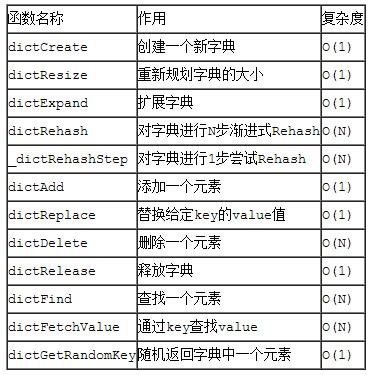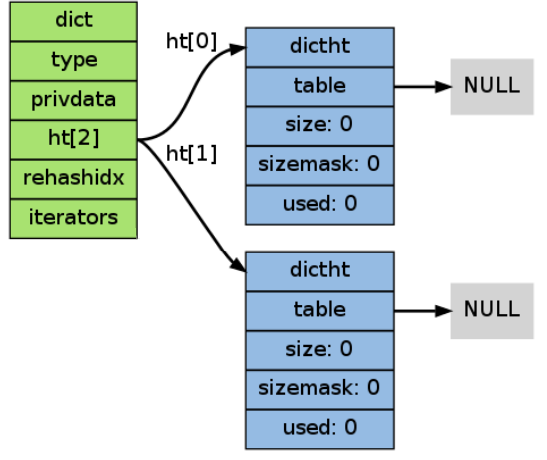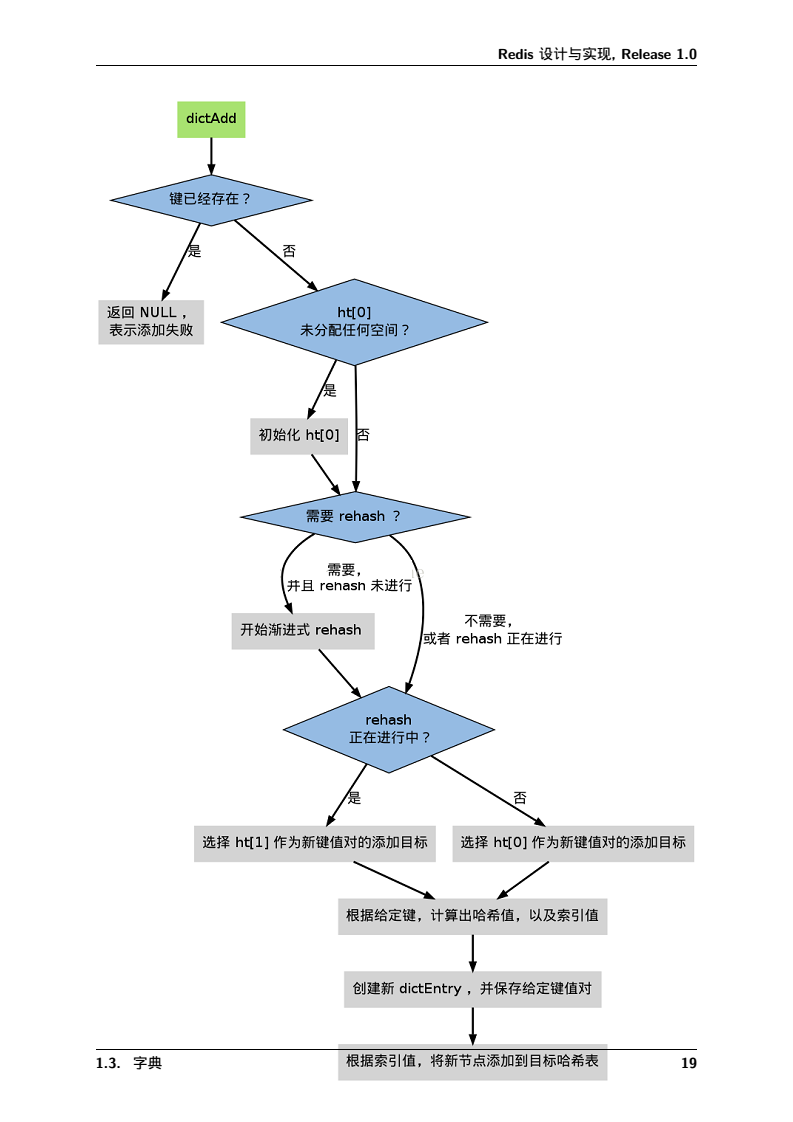| 本文所引用的源码全部来自Redis2.8.2版本。
Redis中字典dict数据结构与API相关文件是:dict.h, dict.c。
本文讲解的不是很详细,可以同时参考Redis实现与设计一书中字典部分,本文关于字典的核心代码的注释可以参考。
字典,简单说就是存储key-value键值数据,当然value=NULL那么就是集合了。字典通俗来说就是C++
STL中的map,STL中的map是用red-black tree实现的,因为map不仅能够保证key不重复,而且key还是按照字典序存储的,而Redis中的字典并不要求有序,因此为了降低编码的难度使用哈希表作为字典的底层实现。Redis的字典是使用一个桶bucket,通过对key进行hash得到的索引值index,然后将key-value的数据存在桶的index位置,Redis处理hash碰撞的方式是链表,两个不同的key
hash得到相同的索引值,那么就使用链表解决冲突。使用链表自然当存储的数据巨大的时候,字典不免会退化成多个链表,效率大大降低,Redis采用rehash的方式对桶进行扩容来解决这种退化。
Redis使用的hash算法有以下两种:
1. MurmurHash2 32 bit 算法:这种算法的分布率和速度都非常好,具体信息请参考
MurmurHash 的主页:http://code.google.com/p/smhasher/ 。
2. 基 于 djb 算 法 实 现 的 一 个 大 小 写 无 关 散
列 算 法: 具 体 信 息 请 参 考
http://www.cse.yorku.ca/~oz/hash.html 。
字典数据结构
typedef struct dictEntry {//字典的节点
void *key;
union {//使用的联合体
void *val;
uint64_t u64;//这两个参数很有用
int64_t s64;
} v;
struct dictEntry *next;//下一个节点指针
} dictEntry;
typedef struct dictType {
unsigned int (*hashFunction)(const void *key); //hash函数指针
void *(*keyDup)(void *privdata, const void *key); //键复制函数指针
void *(*valDup)(void *privdata, const void *obj); //值复制函数指针
int (*keyCompare)(void *privdata, const void *key1, const void *key2); //键比较函数指针
void (*keyDestructor)(void *privdata, void *key); //键构造函数指针
void (*valDestructor)(void *privdata, void *obj); //值构造函数指针
} dictType;
/* This is our hash table structure. Every dictionary has two of this as we
* implement incremental rehashing, for the old to the new table. */
typedef struct dictht { //字典hash table
dictEntry **table;//可以看做字典数组,俗称桶bucket
unsigned long size; //指针数组的大小,即桶的层数
unsigned long sizemask;
unsigned long used; //字典中当前的节点数目
} dictht;
typedef struct dict {
dictType *type;
void *privdata; //私有数据
dictht ht[2]; //两个hash table
int rehashidx; /* rehashing not in progress if rehashidx == -1 */ //rehash 索引
int iterators; /* number of iterators currently running */ //当前该字典迭代器个数
} dict; |
dict数据结构中声明了两个字典hashtable结构dictht,ht[1]在rehash时候使用,后面具体分析。
下图给出整个字典结构,图片来自Redis设计与实现一书:

上图ht[1]为空,说明当然字典没在Rehash状态。
字典的API函数

创建新字典
通过dictCreate函数创建一个新字典dict *dictCreate(dictType
*type, void *privDataPtr),一个空字典的示意图如下(图片来自Redis设计与实现一书):

上面已经提起过,ht[1]只在Rehash时使用。
字典添加元素
根据字典当前的状态,将一个key-value元素添加到字典中可能会引起一系列复制的操作:
如果字典未初始化(即字典的0号哈希表ht[0]的table为空),那么需要调用dictExpand函数对它初始化;
如果插入的元素key已经存在,那么添加元素失败;
如果插入元素时,引起碰撞,需要使用链表来处理碰撞;
如果插入元素时,引起程序满足Rehash的条件时,先调用dictExpand函数扩展哈希表的size,然后准备渐进式Rehash操作。
字典添加元素的流程图,来自Redis设计与实现一书

/* Expand or create the hash table */
int dictExpand(dict *d, unsigned long size)
{
dictht n; /* the new hash table */
unsigned long realsize = _dictNextPower(size); //得到需要扩展到的size
/* the size is invalid if it is smaller than the number of
* elements already inside the hash table */
if (dictIsRehashing(d) || d->ht[0].used > size)
return DICT_ERR;
/* Allocate the new hash table and initialize all pointers to NULL */
n.size = realsize;
n.sizemask = realsize-1;
n.table = zcalloc(realsize * sizeof(dictEntry*));
n.used = 0;
/* Is this the first initialization? If so it's not really a rehashing
* we just set the first hash table so that it can accept keys. */
if (d->ht[0].table == NULL) {
d->ht[0] = n;
return DICT_OK;
}
/* Prepare a second hash table for incremental rehashing */
//准备渐进式rehash,rehash的字典table为0号
d->ht[1] = n;
d->rehashidx = 0;
return DICT_OK;
}
/* Expand the hash table if needed */
static int _dictExpandIfNeeded(dict *d)
{
/* Incremental rehashing already in progress. Return. */
if (dictIsRehashing(d)) return DICT_OK;
// 如果哈希表为空,那么将它扩展为初始大小
if (d->ht[0].size == 0) return dictExpand(d, DICT_HT_INITIAL_SIZE);
/*如果哈希表的已用节点数 >= 哈希表的大小,并且以下条件任一个为真:
1) dict_can_resize 为真
2) 已用节点数除以哈希表大小之比大于 dict_force_resize_ratio
那么调用 dictExpand 对哈希表进行扩展,扩展的体积至少为已使用节点数的两倍
*/
if (d->ht[0].used >= d->ht[0].size &&
(dict_can_resize ||
d->ht[0].used/d->ht[0].size > dict_force_resize_ratio))
{
return dictExpand(d, d->ht[0].used*2);
}
return DICT_OK;
}
static int _dictKeyIndex(dict *d, const void *key)
{
unsigned int h, idx, table;
dictEntry *he;
/* Expand the hash table if needed */
if (_dictExpandIfNeeded(d) == DICT_ERR)
return -1;
/* Compute the key hash value */
h = dictHashKey(d, key);//通过hash函数得到key所在的bucket索引位置
//查找在现有字典中是否出现了该key
for (table = 0; table <= 1; table++) {
idx = h & d->ht[table].sizemask;
/* Search if this slot does not already contain the given key */
he = d->ht[table].table[idx];
while(he) {
if (dictCompareKeys(d, key, he->key))
return -1;
he = he->next;
}
//如果系统没在rehash则不需要查找ht[1]
if (!dictIsRehashing(d)) break;
}
return idx;
}
dictEntry *dictAddRaw(dict *d, void *key)
{
int index;
dictEntry *entry;
dictht *ht;
if (dictIsRehashing(d)) _dictRehashStep(d);// 尝试渐进式地 rehash 桶中一组元素
/* Get the index of the new element, or -1 if
* the element already exists. */
// 查找可容纳新元素的索引位置,如果元素已存在, index 为 -1
if ((index = _dictKeyIndex(d, key)) == -1)
return NULL;
/* Allocate the memory and store the new entry */
ht = dictIsRehashing(d) ? &d->ht[1] : &d->ht[0];
// 决定该把新元素放在那个哈希表
entry = zmalloc(sizeof(*entry));
//头插法,插入节点
entry->next = ht->table[index];
ht->table[index] = entry;
ht->used++;
/* Set the hash entry fields. */
dictSetKey(d, entry, key);//关联起key
return entry;
}
/* Add an element to the target hash table */
//添加一个元素
int dictAdd(dict *d, void *key, void *val)
{
dictEntry *entry = dictAddRaw(d,key);
if (!entry) return DICT_ERR;
dictSetVal(d, entry, val);//关联起value
return DICT_OK;
} |
字典Rehash解析
Rehash的触发机制:当每次添加新元素时,都会对工作哈希表ht[0]进行检查,如果used(哈希表中元素的数目)与size(桶的大小)比率ratio满足以下任一条件,将激活字典的Rehash机制:ratio=used
/ size, ratio >= 1并且dict_can_resize 为真;ratio 大 于
变 量 dict_force_resize_ratio 。
Rehash执行过程:
创建一个比ht[0].used至少两倍的ht[1].table;将原ht[0].table中所有元素迁移到ht[1].table;清空原来ht[0],将ht[1]替换成ht[0]
渐进式Rehash主要由两个函数来进行:
_dictRehashStep:当对字典进行添加、查找、删除、随机获取元素都会执行一次,其每次在开始Rehash后,将ht[0].table的第一个不为空的索引上的所有节点全部迁移到ht[1].table;
dictRehashMilliseconds:由Redis服务器常规任务程序(serverCron)执行,以毫秒为单位,在一定时间内,以每次执行100步rehash操作。
Rehash操作核心函数:
int dictRehash(dict *d, int n) {
if (!dictIsRehashing(d)) return 0;
while(n--) {
dictEntry *de, *nextde;
/* Check if we already rehashed the whole table... */
if (d->ht[0].used == 0) {//已经完成
zfree(d->ht[0].table);//释放ht[0].table
d->ht[0] = d->ht[1]; //这里ht[0]与ht[1]都不是指针,直接赋值就替换了
_dictReset(&d->ht[1]);//将ht[1].table设置为null
d->rehashidx = -1;
return 0;
}
/* Note that rehashidx can't overflow as we are sure there are more
* elements because ht[0].used != 0 */
assert(d->ht[0].size > (unsigned)d->rehashidx);
//找到第一个不为空的数组
while(d->ht[0].table[d->rehashidx] == NULL) d->rehashidx++;
//指向该链表头
de = d->ht[0].table[d->rehashidx];
/* Move all the keys in this bucket from the old to the new hash HT */
while(de) {//遍历链表
unsigned int h;
nextde = de->next;
/* Get the index in the new hash table */
//得到在ht[1]中的索引号,通过相应的hash函数
h = dictHashKey(d, de->key) & d->ht[1].sizemask;
// 添加节点到 ht[1] ,调整指针,采用的是头插法
de->next = d->ht[1].table[h];
d->ht[1].table[h] = de;
d->ht[0].used--;
d->ht[1].used++;
de = nextde;
}
d->ht[0].table[d->rehashidx] = NULL;//设置为空
d->rehashidx++;
}
return 1;
} |
小结
Redis中的字典数据结构使用哈希表来实现,用来存储key-value键值元素;
字典使用两个哈希表,一般只使用ht[0],只有当Rehash时候才使用ht[0];
哈希表采用链表的方式解决键碰撞问题;
Redis的Rehash操作是渐进式的,服务器程序会主动Rehash,在查找、添加、删除元素等操作时也会在Rehash进行时执行一次rehash操作。
字典的内容实在太多,操作比较繁琐,应该是Redis中最复杂的底层数据结构了,本文分析的绝对不够深入,希望以后有时间再修改吧,暂时先这样。到目前为止,Redis六种内部数据结构,同时也是底层操作的实现讲解全部结束,后面的文章将进入五种基本数据类型指令的实现,字符串(String)、哈希表(Hash)、列表(List)、集合(Set)、有序集合(Sorted
Set)的各种指令的实现。
我自己对Redis2.8.2源码的注释,有时间找个机会放出来。
最后感谢黄健宏(huangz1990)的Redis设计与实现及其他对Redis2.6源码的相关注释对我在研究Redis2.8源码方面的帮助。
|

